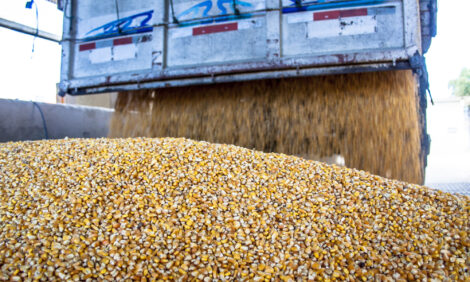



Weekly Purcell Report
US - Agricultural US Commodity Market Report by Wayne D. Purcell, Agricultural and Applied Economics, Virginia Tech.
 Weekly Purcell
Agricultural Commodity Market Report Wayne D. Purcell Agricultural and Applied Economics Virginia Tech |
LEAN HOGS on the CME, APR’06LH contract closed lower on Tuesday off $0.65/cwt at $61.475/cwt while the JUNE’06LH futures contract closed at $69.95/cwt, down $0.125/cwt. The JUNE’06LH fell to a one-week low under the 20-day moving average. Technical selling, long liquidation, and weak cash price pulled at the market. Cash hog prices in many places were fiercely lower on Monday with some lower still on Tuesday. Fund rolling out of April/June long positions also pressured the APR’06LH contract. The CME lean hog index provided some lift in the discount of the April hog futures was unable to hold off long liquidations moved by a weak cash market and rolling by the funds. The CME lean hog index price was up $0.16/cwt at $63.19/cwt. The April index closed at $61.475/cwt. This market was also under the burden of the expected Goldman Sachs Roll. Hedgers should consider protection on a parts of the next two marketing quarters.
Bids for feed stock shipments on Tuesday fell 3¢/bu to 4¢/bu. Signs that feed demand in Europe will decrease because of bird flu induced reductions in flocks and lower poultry consumption. Sweden became the latest country to report presence of the flu after hitting France last week. Expectations are not good for the outlook on flocks in other European states. The U.N. Food and Agriculture Organization expected the crisis would shrink demand for poultry depressing prices. Additionally, global consumption of poultry was expected to fall by 3 million to 81.8 million tonnes this year. This wide range says that estimators really don’t know but are thinking a wide range of consequences looms just ahead.
CORN futures on the CBOT opened steady in choppy trading after strong gains last Friday fueled by commercial buying. The mill stone around the neck of upward efforts of the market were concerns over the global spread of bird flu and reduced feed consumption. Some expected sales were cancelled. In a “flurry-to-the-finish“ range-bound and choppy trading, the MAR’06 contract closed up 0.4¢/bu at $2.280/bu and the DEC’06 futures ended down 0.2 cents at $2.642/bu.
Deliveries on the MAR’06 contract were lighter than anticipated. Tuesday was the first notice day for deliveries. Basis bids were mostly steady yesterday and today as buyers encouraged farmers to sell. Weather faded as a market moving factor as showers and forecasts of more are helping to mature the corn. Friday’s CVTC commitments of trader report for futures and options showed funds and other large speculators up 17,529 from the previous week at 240,260 lots, with short positions up 3,025 lots to 94,368. Resistance on the DEC’06 contract is at the new life-of-contract high, $2.644/bu.
Looking at last week’s advice, that price could still climb it is obvious that it did just that. This may be a very important point in this contract. Cash sellers should very seriously consider forward pricing up to 50% - 60% of new crop sales. Hedgers should look at maintaining short positions at the 50% level. It would not be out of the question to increase short positions to 60% level at this point.
SOYBEANS on the CBOT were up in final trading as funds covered long positions in closing activity. MAR’06 futures closed up 1.4¢/bu at $5.81/bu and the NOV’06 contract finished up 2.6¢/bu at $6.184/bu. The market started sluggishly down in opening bids to trade in choppy both directions all day as traders wait on word of a monstrous U.S. and world supply in the soy complex, floor sources said. Another concern voiced by two traders was, “Where are all the feed stocks going if the bird flu continues to spread?“ Good question.
Weather news didn’t help the market either with news of rainfall filling pods in Argentina. Prior to noon cash bids for soybeans tumbled amid a rally in futures but while other grains held steady. Cash basis bids for soybeans softened at River terminals while those in some Midwestern points were supportive early on as buyers attempted to entice farm sales. Cash bids for soybeans in Atlantic states held steady to slightly higher. The ’05 soybean crop should have been long since sold by now. Cash sellers should consider having up to 35-40% of the ’06 crop priced at this time. Hedgers should think about maintaining short hedges on 45% of the crop.
WHEAT futures on the CBOT were steady after dry weather worries rallied prices to contract highs in the southern Plains. Dry warm weather remained a key trading factor. By mid-afternoon the bears were in control pushing prices off their peaks from a downturn in soybeans. The MAR’06 wheat contract finished down 3¢/bu at $3.702/bu with the JULY’06 futures off 2.4¢/bu at $3.934/bu. The downturn was a disappointment after Monday’s late fund-led rally.
The market was supported by worries of a short crop as Texas and Oklahoma remained dry. The Texas crop reporting service said late Monday that 89% of its HRW crop condition rating was poor to very poor. Forecasts called for more dry, warm conditions for the next 5 days. The rumblings yesterday and today of fresh export deals with Iraq and Iran could not be confirmed. U.S. wheat sales got a lift as Japan tendered an offer for 167,000 tonnes (6.1 million bushels) of wheat. As the CBOT March contract enters delivery time contracts started rolling bids from CBOT March to CBOT May. Cash sellers should think about selling up to 30%-35% of the ’06 crop. Hedgers should be short in the Kansas City market up to 35% of the crop at $4.30/bu.








